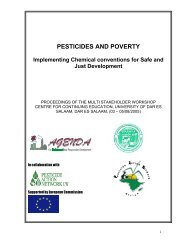Your Daily Poison - Pesticide Action Network UK
Your Daily Poison - Pesticide Action Network UK
Your Daily Poison - Pesticide Action Network UK
You also want an ePaper? Increase the reach of your titles
YUMPU automatically turns print PDFs into web optimized ePapers that Google loves.
2<br />
Executive summary<br />
This new report, the second in the series 1 ,<br />
examines in detail government information<br />
accessible to the public about exposures to<br />
pesticides we all have, on a daily basis, in our<br />
food, water, and the environment. The previous<br />
report covered 2003 figures, and this report<br />
covers exposures in 2004 from published<br />
sources. We highlight the paucity of accessible<br />
information available, not just to the public, but to<br />
decision-makers at a local level: local authorities,<br />
water companies and health professionals, who<br />
are responsible for protecting public health. The<br />
implications of an important new report by the<br />
Royal Commission on Environmental Pollution<br />
(RCEP) ‘Crop spraying and the health of<br />
residents and bystanders’ 2 , for all forms of<br />
pesticide exposure, are assessed.<br />
Our main findings:<br />
◆ An analysis of results from <strong>UK</strong> regulators and<br />
the latest European Commission data<br />
indicates that levels of pesticide residues in<br />
food are increasing in the <strong>UK</strong> and are<br />
significant across Europe, with consequent<br />
health risks<br />
◆ Survey results in this report confirm the<br />
widespread presence of pesticides as lowlevel<br />
contaminants in drinking water. Because<br />
of advances in technology, it has become<br />
evident that the legal limit for pesticides in<br />
treated water needs revision<br />
◆ <strong>Pesticide</strong>s which have been contaminating<br />
drinking water ever since they were<br />
approved: atrazine, isoproturon, mecoprop<br />
and simazine, are still widespread in drinking<br />
water<br />
◆ The post-approvals monitoring for pesticides<br />
in food and water is inadequate, because<br />
insufficient numbers of pesticides are tested<br />
for, even though there is evidence of their<br />
use<br />
◆ Because the government has not set<br />
standards and protocols for the selection of<br />
specific pesticides to be tested for in food<br />
and water, and the analysis of results,<br />
existing strategies are inconsistent.<br />
See our recommendations on page 17.<br />
Introduction<br />
This report of pesticide exposures in 2004<br />
follows up evidence of exposures in 2003,<br />
published as the report People’s <strong>Pesticide</strong><br />
Exposures – poisons we are exposed to every<br />
day without knowing it. The public has the right<br />
to know the extent to which we are all exposed<br />
to pesticides in our food, water and the<br />
environment. Information in this report is sourced<br />
from government monitoring data, and set out in<br />
an accessible form alongside more detailed data<br />
we collect from the authorities by questionnaire<br />
survey, and our own results. The intention is to fill<br />
in some of the gaps in government-disclosed<br />
data, and identify areas in which information is<br />
not available either because it is not collected or<br />
because it is kept secret. Trends are also<br />
described where possible.<br />
Since the last report, the government has<br />
published its National Strategy for the<br />
Sustainable Use of Plant Protection Products.<br />
The strategy does not encompass a plan for<br />
overall reduction of pesticide use, and it does not<br />
yet include a section on protecting human health<br />
from the effects of pesticides. The government<br />
supports an industry-controlled programme, the<br />
Voluntary Initiative, to attempt the reduction of<br />
harmful effects of pesticides on the environment,<br />
the success of which is limited 3 . Overall pesticide<br />
use remains high: over 31,000 tonnes of active<br />
ingredient are applied to <strong>UK</strong> farmland per year<br />
(Appendix 1). The government asked the Royal<br />
Commission on Environmental Pollution (RCEP)<br />
to carry out an independent investigation into the<br />
health impacts of pesticides, and its report,<br />
published in September 2005, made important<br />
recommendations to protect human health from<br />
pesticide exposure.<br />
Sources of published government information<br />
include the Health & Safety Executive, the<br />
<strong>Pesticide</strong>s Safety Directorate (Defra) the<br />
Advisory Committee on <strong>Pesticide</strong>s, the National<br />
<strong>Poison</strong>s Information Service, the <strong>Pesticide</strong><br />
Residues Committee; and the Drinking Water<br />
Inspectorate. Additional information is provided<br />
by PAN <strong>UK</strong>’s own surveys.<br />
There are summaries of the organisations<br />
involved in the regulation of pesticides and<br />
pesticide laws, and the regulatory testing and<br />
assessment of pesticides at Appendices 2 and 3.<br />
<strong>Your</strong> daily poison

















